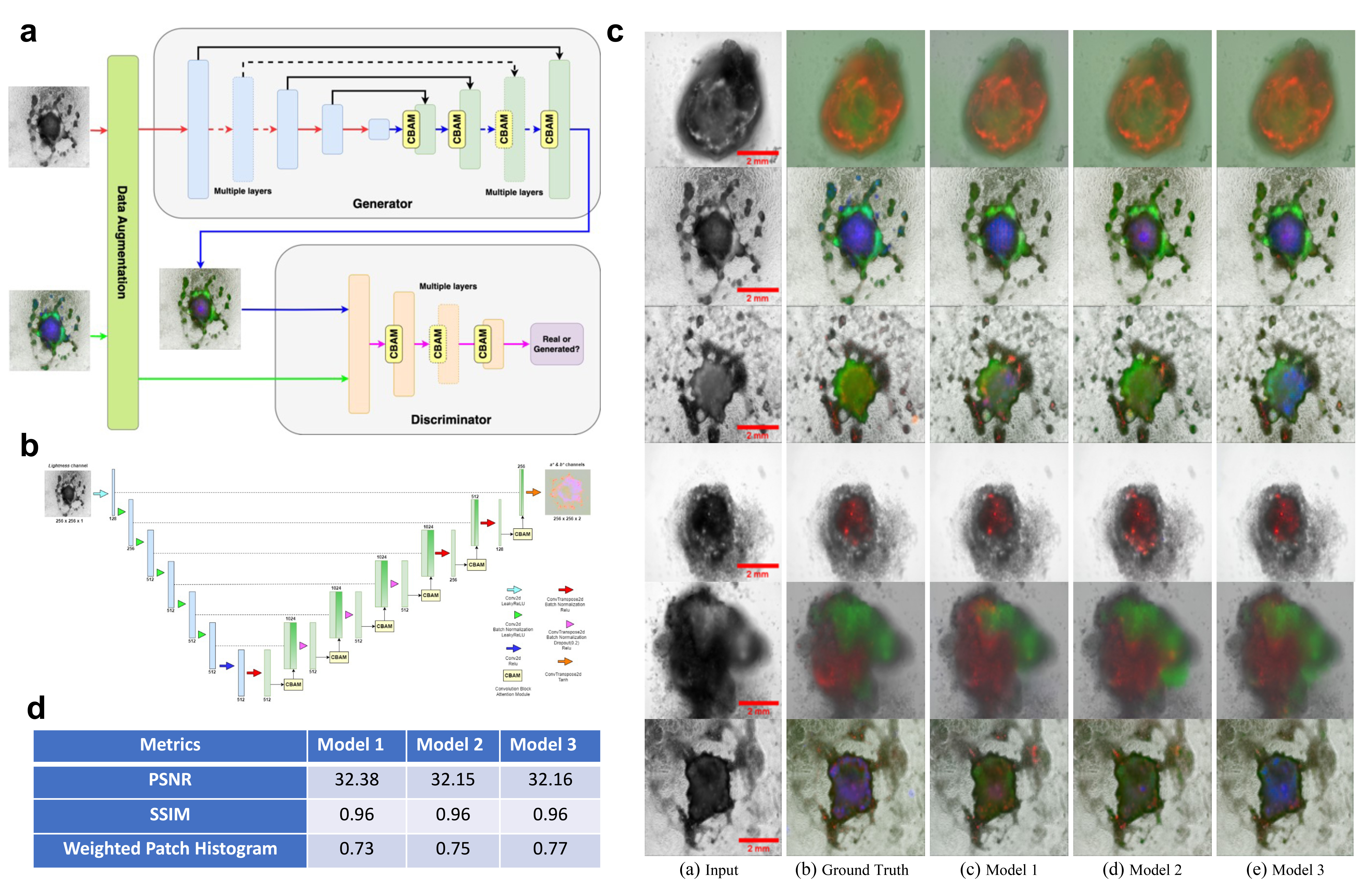Final ID: We016
Generative Artificial Intelligence for hPSC-derived Cardiac Organoid Florescence Generation
Abstract Body: Background: Human pluripotent stem cell (hPSC)-derived cardiac organoids (COs) are extensively applied in modeling heart development and disease. COs are daily monitored by bright-field microscopic imaging for tracking organoid differentiation, morphology, and size, however, it does not provide important information on cell distribution and network in COs. Then, fluorescence microscopic imaging is required with extra steps of experiments when multiple hPSC lines are required. Recently, generative artificial intelligence (AI) has been increasingly applied for image colorization, which extends the possibility of colorizing COs with fluorescence from phase/contrast images. While the phase/contrast image is routinely applied and conveniently used in every biomedical lab daily, is it possible to generate accurate and useful fluorescence information or image colorization from the phase/contrast images of cardiac organoids under the same differentiation protocol is crucial for a broader characterization and analysis of hPSC-derived cardiac organoids and further applications?
Hypothesis: We hypothesize that generative AI will generate accurate fluorescence images from phase/contrast images of COs.
Approach: 1300 images from COs (differentiated from one reporter hPSC line) were used as the training dataset for the Pix2Pix Conditional Generative Adversarial Networks (GANs) model (Fig.1a) with the Convolution Block Attention Module (CBAM) in the U-Net generator (Fig.1b). Three models were designed: U-Net (Model 1), U-Net generator with CBAM (Model 2), and U-Net with CBAM and Generator Iteration (Model 3). Three different metrics were included: Peak Signal-to-Noise Ratio (PSNR), Structural Similarity Index (SSIM), and Weighted Patch Histogram to evaluate the prediction outcomes.
Results: The predicted fluorescence images from phase/contrast images of different COs are very similar to the ground truths (Fig.1c). The similarities evaluated by all three metrics (Fig.1d) have the scores of PSNR over 30, SSIM over 0.92, and a Weighted Patch Histogram score over 0.75, which are the most accurate and similar to the ground truth.
Conclusions: A generative AI model was established to colorize phase images of COs using cGANs and CBAM, which capture intricate fluorescence details to support the biomedical research of COs with enhanced interpretability and analysis of cardiac organoid morphology and structure in biomedical research and applications.
Hypothesis: We hypothesize that generative AI will generate accurate fluorescence images from phase/contrast images of COs.
Approach: 1300 images from COs (differentiated from one reporter hPSC line) were used as the training dataset for the Pix2Pix Conditional Generative Adversarial Networks (GANs) model (Fig.1a) with the Convolution Block Attention Module (CBAM) in the U-Net generator (Fig.1b). Three models were designed: U-Net (Model 1), U-Net generator with CBAM (Model 2), and U-Net with CBAM and Generator Iteration (Model 3). Three different metrics were included: Peak Signal-to-Noise Ratio (PSNR), Structural Similarity Index (SSIM), and Weighted Patch Histogram to evaluate the prediction outcomes.
Results: The predicted fluorescence images from phase/contrast images of different COs are very similar to the ground truths (Fig.1c). The similarities evaluated by all three metrics (Fig.1d) have the scores of PSNR over 30, SSIM over 0.92, and a Weighted Patch Histogram score over 0.75, which are the most accurate and similar to the ground truth.
Conclusions: A generative AI model was established to colorize phase images of COs using cGANs and CBAM, which capture intricate fluorescence details to support the biomedical research of COs with enhanced interpretability and analysis of cardiac organoid morphology and structure in biomedical research and applications.
More abstracts on this topic:
A Machine Learning Readmission Risk Prediction Model for Cardiac Disease
Bailey Angela, Wang Wei, Shannon Clarence, Huling Jared, Tignanelli Christopher
A Novel EMR-Based Algorithm with the Virtual Echocardiography Screening Tool (VEST) to Screen Patients for Pulmonary Arterial HypertensionNarowska Gabriela, Anand Suneesh, Gangireddy Chethan, Enevoldsen John, Keane Martin, Edmundowicz Daniel, Forfia Paul, Vaidya Anjali

